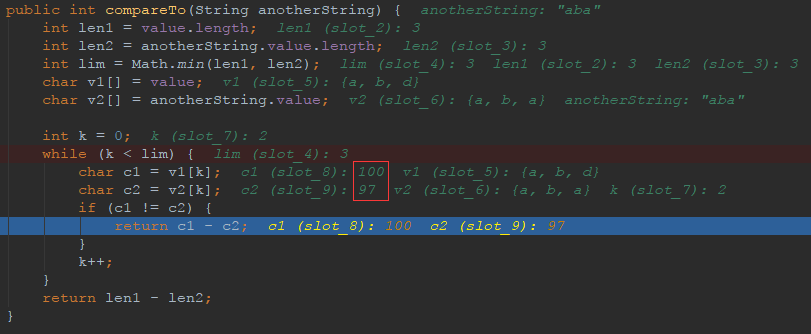String类对象的比较
1.字符串比较,是按照字符串(String)中每一个字符(char)的字段表顺序进行比较
/**
* Compares two strings lexicographically(字典序,按照字典顺序).
* The comparison is based on the Unicode value of each character in
* the strings. The character sequence represented by this
* {@code String} object is compared lexicographically to the
* character sequence represented by the argument string. The result is
* a negative integer if this {@code String} object
* lexicographically precedes(先于) the argument string. The result is a
* positive integer if this {@code String} object lexicographically
* follows the argument string. The result is zero if the strings
* are equal; {@code compareTo} returns {@code 0} exactly when
* the {@link #equals(Object)} method would return {@code true}.
* <p>
* This is the definition of lexicographic ordering. If two strings are
* different, then either they have different characters at some index
* that is a valid index for both strings, or their lengths are different,
* or both. If they have different characters at one or more index
* positions, let <i>k</i> be the smallest such index; then the string
* whose character at position <i>k</i> has the smaller value, as
* determined by using the < operator, lexicographically precedes the
* other string. In this case, {@code compareTo} returns the
* difference of the two character values at position {@code k} in
* the two string -- that is, the value:
* <blockquote><pre>
* this.charAt(k)-anotherString.charAt(k)
* </pre></blockquote>
* If there is no index position at which they differ, then the shorter
* string lexicographically precedes the longer string. In this case,
* {@code compareTo} returns the difference of the lengths of the
* strings -- that is, the value:
* <blockquote><pre>
* this.length()-anotherString.length()
* </pre></blockquote>
*
* @param anotherString the {@code String} to be compared.
* @return the value {@code 0} if the argument string is equal to
* this string; a value less than {@code 0} if this string
* is lexicographically less than the string argument; and a
* value greater than {@code 0} if this string is
* lexicographically greater than the string argument.
*/
public int compareTo(String anotherString) {
int len1 = value.length;
int len2 = anotherString.value.length;
int lim = Math.min(len1, len2);
char v1[] = value;
char v2[] = anotherString.value; int k = 0;
while (k < lim) {
char c1 = v1[k];
char c2 = v2[k];
if (c1 != c2) {
return c1 - c2;
}
k++;
}
return len1 - len2;
}
String str1 = "abd";
String str2 = "aba";
int res1 = str1.compareTo(str2);
//
System.out.println(res1);

String str1 = "Abd";
String str2 = "aba";
int res1 = str1.compareTo(str2);
//-32
System.out.println(res1);
2.比较时忽略大小写
/**
* Compares two strings lexicographically, ignoring case
* differences. This method returns an integer whose sign is that of
* calling {@code compareTo} with normalized versions of the strings
* where case differences have been eliminated by calling
* {@code Character.toLowerCase(Character.toUpperCase(character))} on
* each character.
* <p>
* Note that this method does <em>not</em> take locale into account,
* and will result in an unsatisfactory ordering for certain locales.
* The java.text package provides <em>collators</em> to allow
* locale-sensitive ordering.
*
* @param str the {@code String} to be compared.
* @return a negative integer, zero, or a positive integer as the
* specified String is greater than, equal to, or less
* than this String, ignoring case considerations.
* @see java.text.Collator#compare(String, String)
* @since 1.2
*/
public int compareToIgnoreCase(String str) {
return CASE_INSENSITIVE_ORDER.compare(this, str);
}
String str1 = "Abd";
String str2 = "aba";
int res = str1.compareToIgnoreCase(str2);
//
System.out.println(res);
String类对象的比较的更多相关文章
- 反射消除String类对象的不可变特性
大家都知道,在JAVA中字符串一旦声明就不可改变,如果尝试修改字符串的内容,将会重新实例化一个新的字符串对象,这也是为了安全性和效率. 由于字符串在程序之中被大量使用,所以JAVA引入了一个字符串常量 ...
- java笔记--String类对象解析与运用
--如果朋友您想转载本文章请注明转载地址"http://www.cnblogs.com/XHJT/p/3877236.html "谢谢-- 1.String中的equals和==的 ...
- String类对象两种实例化方式比较
第一种:直接赋值 String str = "hello!" ; 在java中,有一个字符串常量池,对于这种直接赋值的,会直接写进常量池(常量池里面不存在其value,) 自JD ...
- JAVA笔记3__字符串String类/对象一对一关联
import java.lang.String; import java.util.Scanner; public class Main { public static void main(Strin ...
- c++中string类对象和字符数组之间的相互转换
string类在c++中是一个模板类,位于名字空间std中,注意这里不是string.h,string.h是C字符串头文件. 将string类型转换为字符数组char arr[10];string s ...
- String类对象相加时做了什么
我们都知道java中的加号操作符除了加法.表示正数之外,还可以用作字符串的连接.初学java时,你很可能会碰到类似下面的题目: 以下这段代码产生了几个String对象: String str1 = & ...
- Scanner类、匿名对象、Random类、ArrayList集合、String类、static静态类、math类和Arrays工具类
一.Scanner类 1.除了八种基本数据类型,其他都是引用类型: 引用类型使用三步骤: 2.Scanner类 引用jdk提供的类,Scanner在java.util包下,不在java.lang包(S ...
- String类和StringBuffer类的区别
首先,String和StringBuffer主要有2个区别: (1)String类对象为不可变对象,一旦你修改了String对象的值,隐性重新创建了一个新的对象,释放原String对象,StringB ...
- 【Java 进阶篇】【第一课】String类
引用 String类包含在java.lang包中.这个包会在Java启动的时候自动import,所以可以当做一个内置类(built-in class).我们不需要显式的使用import引入String ...
随机推荐
- 【Java】 String类型的==使用
public class StringDemo { public static void main(String[] args) { String s1 = "abc"; Stri ...
- docker动态绑定端口
一.背景 在创建容器的时候,我们可以使用命令 docker container run -p host:container container-name 的方式来绑定端口,还可以使用docker-co ...
- 洛谷P1527 [国家集训队] 矩阵乘法 [整体二分,二维树状数组]
题目传送门 矩阵乘法 题目描述 给你一个N*N的矩阵,不用算矩阵乘法,但是每次询问一个子矩形的第K小数. 输入输出格式 输入格式: 第一行两个数N,Q,表示矩阵大小和询问组数: 接下来N行N列一共N* ...
- ASL测试 课题测试博客
已知线性表具有元素{5,13,19,21,37,56,64,75,80,88,92},如果使用折半查找法,ASL是多少? 知识点1: 折半查找法:折半查找,又称作二分查找.这个查找的算法的特点,要求数 ...
- Java 中的数据类型
我们学习Java就是为了编写程序完成功能,而什么是程序呢?程序 = 数据结构 + 算法. 分开看,数据结构指的是数据与数据之间的关系,那我们先来了解一下Java中的数据都是怎么表示的呢 ?也就是说数据 ...
- 一列道出yield和生成器的真谛
均匀大小的块 def chunks(l, n): """Yield successive n-sized chunks from l.""" ...
- luoguP3952 [NOIP2017]时间复杂度 模拟
原本只是想看下多久能码完时间复杂度 然后在30min内就码完了,然后一A了???? 首先,这题完全可以离线做 我们先把所有的操作读完,判断合不合法之后,再去判断和标准答案的关系 具体而言 把所有的操作 ...
- 【单调队列】BZOJ1342-[Baltic2007]Sound静音问题
[题目大意] 给出一个n个数的序列,以哪位位置为开头的长度为m的区间满足该区间的最大值与最小值的差≤一个定值. [思路] 单调队列……说一下单调队列比较方便的操作. 把第一个先丢进去,开始条件为hea ...
- voith项目配置服务程序
项目需求: 1.程序可以最小化到任务栏 2.tpms标签和限速标签同时只能选择一个,并且要通过button确定修改 3.在程序中需要显示SequenceScanner1.0服务的运行状态 4.能够打开 ...
- java值和地址值传递、字符串常量池的理解
#java值和地址值传递的理解: - 基本数据类型和基本数据类型的封装类都是:值传递 * 形式参数的改变不会影响实际参数的改变(相当于将值复制一份传递给形参,自身没做任何改变) - 引用数据 ...
